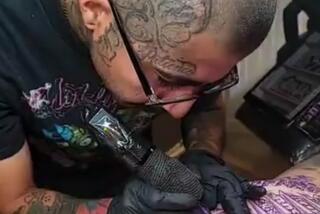Solving Cases Can Hinge on Thin Gray Line
- Share via
Sgt. Michael Streed says he can’t help but feel a sense of pride as the prosecution of Alejandro Avila, accused of molesting and killing 5-year-old Samantha Runnion, picks up steam in Orange County.
Streed was asked to tap the memory of a 5-year-old girl named Sarah, the only witness to Runnion’s 2002 abduction from outside her Stanton home, and create the face of the kidnapper. People who saw his sketch and recognized Avila, who has pleaded not guilty, provided the tips that led to his arrest.
“The ultimate goal and ultimate satisfaction is seeing a violent criminal brought in,” said Streed, who works for the Orange Police Department.
Eyewitness identification is not a perfect investigative tool. But the sketch artists who exploit it have been integral to solving many high-profile cases, including Unabomber Theodore Kaczynski, Elizabeth Smart’s kidnapping and the Oklahoma City bombing.
“We’re unusual in the forensic world in that we’re not a true science,” said Sgt. Steve Johnson, chairman of the forensic art certification board of the International Assn. for Identification, a nationally recognized forensic society based in Minnesota. “We’re an investigative tool. We’re only as good as the memory and recollection of a witness. That and the talent we bring to the table.”
Johnson, who sketches for the Davenport Police Department in Iowa, said Streed is among a select group of less than 30 police artists in the country who are certified by his organization.
He estimates there are an additional 100 artists who haven’t been certified, mostly because police generally don’t require it.
To gain certification, artists must have drawn at least 18 sketches and had two “hits” -- sketches that led to arrests.
Like Streed and Johnson, most forensic artists are full-time law enforcement officials with an interest in art. They train at the FBI academy or at a weeklong course in Scottsdale, Ariz.
“Most agencies aren’t of the size that they can afford a full-time sketch artist, or their violent crime rate is fairly low,” said Streed, estimating that there are less than 20 full-time artists at police departments across the country. Sandie Enslow sketches full time for the Los Angeles County Sheriff’s Department.
For the LAPD, civilian Marilyn Droz completes between 30 and 40 sketches each month, primarily in robbery, homicide and sex crime cases.
Droz said sketches don’t have to be exact to be helpful.
“Sometimes they turn out remarkably close to the people,” Droz said. “But if they’re not exact, they’ll still give enough information about the person to narrow down the investigation tremendously.”
Many agencies use software to generate computer images. Droz said those images generally look like cartoons or photographs.
“People dismiss the cartoony ones. And when people look at [the realistic ones], they expect that the [suspect] will look exactly like that,” said Droz, who’s been a forensic artist for 27 years. “Whereas in a drawing, they know it’s an interpretive process, so they’ll look at a broader range of suspects.”
To develop viable sketches, the artists say a good eye and artistic talent are important but secondary to strong interviewing skills and an understanding of how human memory works.
Artists will take the person back to the scene of the crime using what they call a cognitive interviewing technique, in which they ask open-ended, non-leading questions.
“I take them back in their mind to the scene of the crime,” Streed said. “Some people say that re-traumatizes them. But trauma embeds events much better than no trauma.”
Once he has elicited as much of the victim or witness’ verbal recall as possible, Streed will show them photographs of facial features that mimic what they described.
“If they described a flat nose, I may show them 16 varieties of flat noses,” Streed said. “People’s recognition skills are stronger than their verbal skills.”
Not all artists use recognition skills or show photographs.
And the time it takes them to draw a composite varies as well. Streed said the interview and drawing takes him an average of 2 1/2 hours. Johnson said he finishes the work in an hour.
Sketch artists say the best part of their job is empowering a victim or witness to help catch the criminal.
“It really is very healing for these people to be involved in working on the case,” Droz said. “They go from being a victim to being a part of the process of catching the person and preventing the crime from happening to someone else.”
More to Read
Sign up for Essential California
The most important California stories and recommendations in your inbox every morning.
You may occasionally receive promotional content from the Los Angeles Times.










